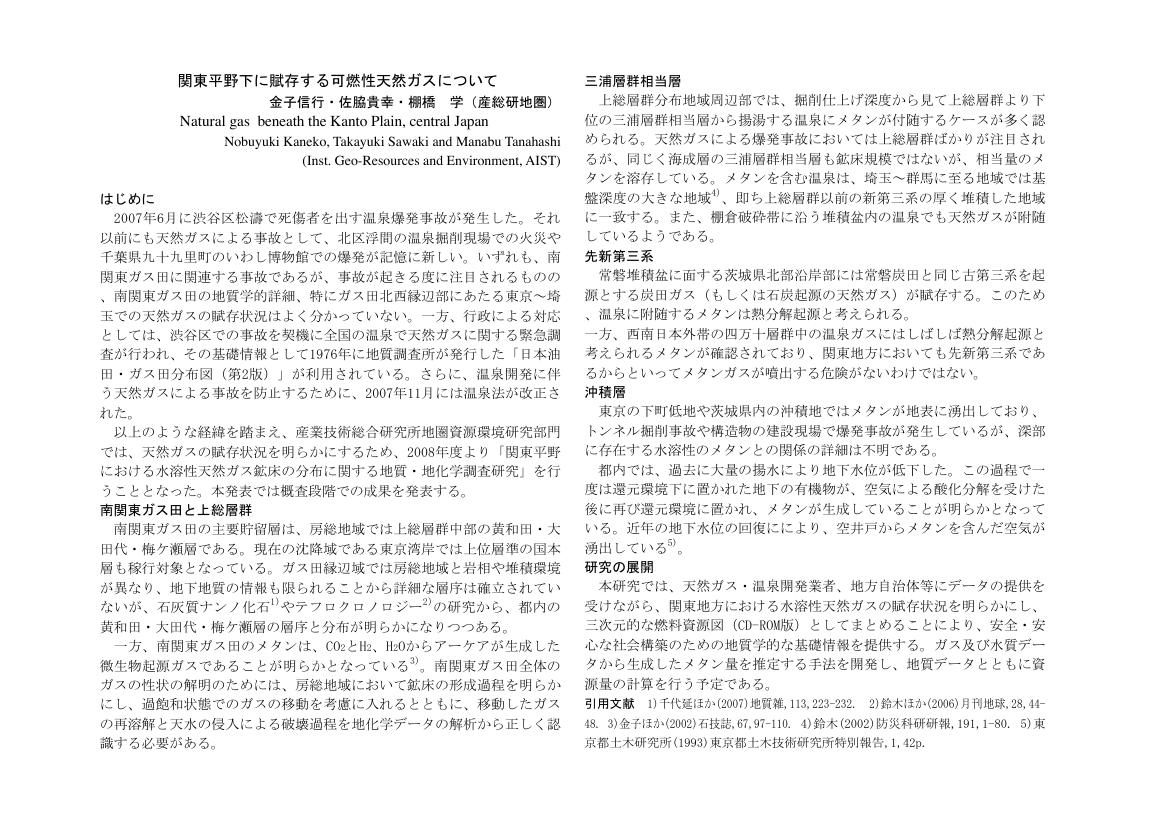3 0 0 0 OA 2003年十勝沖地震に伴い千歳市泉郷地区で噴出した天然ガスの起源
- 著者
- 金子 信行 猪狩 俊一郎
- 出版者
- 石油技術協会
- 雑誌
- 石油技術協会誌 (ISSN:03709868)
- 巻号頁・発行日
- vol.70, no.3, pp.241-249, 2005 (Released:2007-06-01)
- 参考文献数
- 21
The 2003 Tokachi-oki Earthquake induced natural gas to gush out at several points in the Izumisato area of Chitose city, central Hokkaido, on September 26th. Four gas samples were taken on October 2nd and conspicuous gas seeping continued for a maximum of a month. Chemical and isotopic compositions of the gas revealed that methane was produced by CO2-reductive/hydrogenophiric methanogen and there were two different origins.Three samples had a N2-rich, CO2-depleted composition, and its methane was relatively depleted in 13C. Enrichment in N2 implies a non-marine source, but the thickness of the late Pleistocene Higashichitose formation around Izumisato is only about 20m, which is inadequate for explaining the discharged gas volume. Therefore the gas might be generated in the Higashichitose formation beneath the Ishikari lowland, and migrated upward through the strata and along the underlying uncorformity. Some gas was emitted through Izumisato fault, but the rest of the gas accumulated at a shallow depth in the eastern area from the fault, and was quickly discharged by the earthquake. Dissolution of CO2 in the formation water through these processes resulted in a low CO2 content in the gas.The other sample had a completely different compositions than the three samples. The gas was supposed to be generated in the marine Neogene Oiwake formation and migrated through or near the fault. This seepage seemed to be continuous and not related with the earthquake.
3 0 0 0 OA 関東平野下に賦存する可燃性天然ガスについて
- 著者
- 金子 信行 佐脇 貴幸 棚橋 学
- 出版者
- 一般社団法人 日本地質学会
- 雑誌
- 日本地質学会学術大会講演要旨 第115年学術大会(2008秋田) (ISSN:13483935)
- 巻号頁・発行日
- pp.426, 2008 (Released:2009-02-20)
- 参考文献数
- 6
- 著者
- 鹿野 和彦 金子 信行 千葉 とき子
- 出版者
- 特定非営利活動法人 日本火山学会
- 雑誌
- 日本火山学会講演予稿集 2014 (ISSN:24335320)
- 巻号頁・発行日
- pp.69, 2014-11-02 (Released:2017-02-10)
1 0 0 0 OA アーケアによるメタンの生成と間隙水への濃集機構
- 著者
- 金子 信行 前川 竜男 猪狩 俊一郎
- 出版者
- 石油技術協会
- 雑誌
- 石油技術協会誌 (ISSN:03709868)
- 巻号頁・発行日
- vol.67, no.1, pp.97-110, 2002 (Released:2015-06-05)
- 参考文献数
- 76
- 被引用文献数
- 6 21
Generation of "bacterial" methane by Archaea and its accumulation mechanism into interstitial water in early diagenesis were investigated by a mass balance calculation for observed isotopic compositions and geological evolution through aggradation from bathyal sediments for several hydropressured (so-called "dissolved-in-water type") natural gas fields in Japan. Hydrogen isotopic ratios of methane from the Minami-Kanto and Niigata gas fields reveal that CO2-reduction was the main reaction of the methane formation, and its carbon isotopic ratios show a concentration between -67 and -66%_0 relative to PDB. Model calculation in a semi-closed system based on coexisting carbon isotopic compositions of methane and dissolved inorganic carbon for the Minami-Kanto gas field reveals the considerable contribution of carbonate minerals to both compositions. For example, if CO2 had been supplied only from organic matter, the efficiency of methane generation would have been as low as 40%. Whereas, if methane generation rate had been equal to the input rate of CO2 from organic matter, the dissolution and precipitation of carbonate minerals and/or isotope exchange reaction between dissolved inorganic carbon and carbonate minerals should have occurred about nine times faster than methane generation. From a geological standpoint, it is inferred that the existence of thick marine argillaceous sediments rich in terrigenous organic matter and carbonate minerals was important for the generation of archaeal methane and adsorption of iodine. Accumulation of methane and iodine into interstitial water must have been promoted when interacting solid/liquid ratio of sediments was increased by the burial suppression of interstitial water caused by basin subsidence, sedimentation of sandstone, recovery of abnormal compaction and/or dehydration of clay minerals and other causes. Interstitial water dissolving methane and iodine in thick marine argillaceous rocks was removed to the upper sand/silt or mud interbeds, which had higher sedimentation rates, with the compaction and burial of solid sediments.

